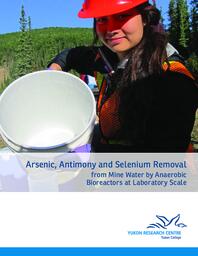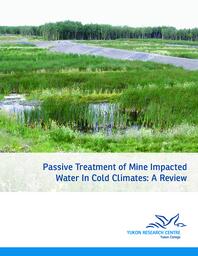Ness, Isobel
Person Preferred Name
Isobel Ness
Affiliation
Related Works
Content type
Digital Document
Description / Synopsis
Passive water treatment technologies are increasingly being considered for mine site closure in the Yukon and efforts are currently underway to test, compare and contrast passive treatment technologies with conventional technologies. This study aims to provide additional information about the effectiveness of passive treatment technologies for mine water treatment in cold climates. To test the hypothesis that bioreactors can effectively treat mine-impacted water at low temperatures, four bench-scale, continuous flow bioreactors were assessed for their potential to remove As, Se and Sb from mine effluent. The experiment was conducted as part of the work undertaken by the Yukon Mine Research Consortium; an industrial research body which conducts research on remediation and reclamation of Yukon mine sites to further enhance environmental stewardship in the territory. More specifically, the objectives of this study were to 1) assess the efficiency of removal of As, Sb and Se, three metalloids, from a highly contaminated synthetic drainage in cold conditions as well as from actual leachate collected at the Eagle Gold site, 2) evaluate the impact of using wood chips as part of the composition of the bioreactor and 3) assess the impact of freeze/thaw on the bioreactors’ performance. Four bioreactors in columns were built in the Yukon Research Centre lab and operated for 5 months to treat both synthetic influent and leachate collected at Eagle Gold during summer 2014. Operation was phased as follows: Phase 1) the bioreactors were operated in an environment with uncontrolled temperature in the fall until the bioreactors froze solid; Phase 2) the bioreactors were thawed in a fridge at a stable temperature of 6°C; Phase 3) the bioreactors were operated and monitored at 6°C. Results show that all bioreactors significantly decreased As, Sb and Se concentrations even when the influent concentration was high (mimicking the “worst case scenario”). However, even though As reduction was efficient, it was not quite enough to bring the concentrations below the discharge limit threshold of 0.15 ug/L. Using drainage produced on site, 38%, 90% and 95% of As, Se and Sb was removed. Using highly contaminated drainage with an average of 5 mg/L As, 0.5 mg/L Se and 0.03 mg/L Sb, the removal efficiencies were recorded at >85% for Sb, >87% for As, and >99% for Se. This study is one of very few studies reported in the literature which demonstrates antimony removal from water by an anaerobic bioreactor. In addition to the metal removal performance assessment, the results indicate that addition of 20% spruce chips in the composition of the bioreactor substrate improved As removal in the first phase of the study and helped mitigate the impact of freeze/thaw on As, Sb and Se.
Origin Information
Content type
Digital Document
Description / Synopsis
In this review, we evaluate the challenges encountered and the adaptations required for the successful treatment of mine-impacted waters in cold climates with Passive Treatment Systems (PTSs). Engineered PTSs are modeled on natural wetlands, which have been shown to effectively treat water with high metal concentrations through natural attenuation. PTSs include constructed wetlands, bioreactors, and hybrid systems. Some of the challenges associated with implementing cold climate PTSs include cold temperatures, remote locations and limited access in winter, which can lead to freezing pipes and surface water, variable seasonal flow, and low productivity of microbial and macrophytic communities. Many adaptations have been implemented to address these cold climate challenges including burial of pipes to avoid hydraulic failure, insulation to avoid freezing surface waters, bypasses and overflows to maintain constant flow, summer establishment of microbial and macrophytic communities and the addition of liquid carbon sources to offset reduced organic matter decomposition in cold temperatures. While further investigation and development is necessary to fully understand the factors affecting cold climate PTSs, with sufficient research and planning PTSs can be successfully implemented in cold climates.
Origin Information


